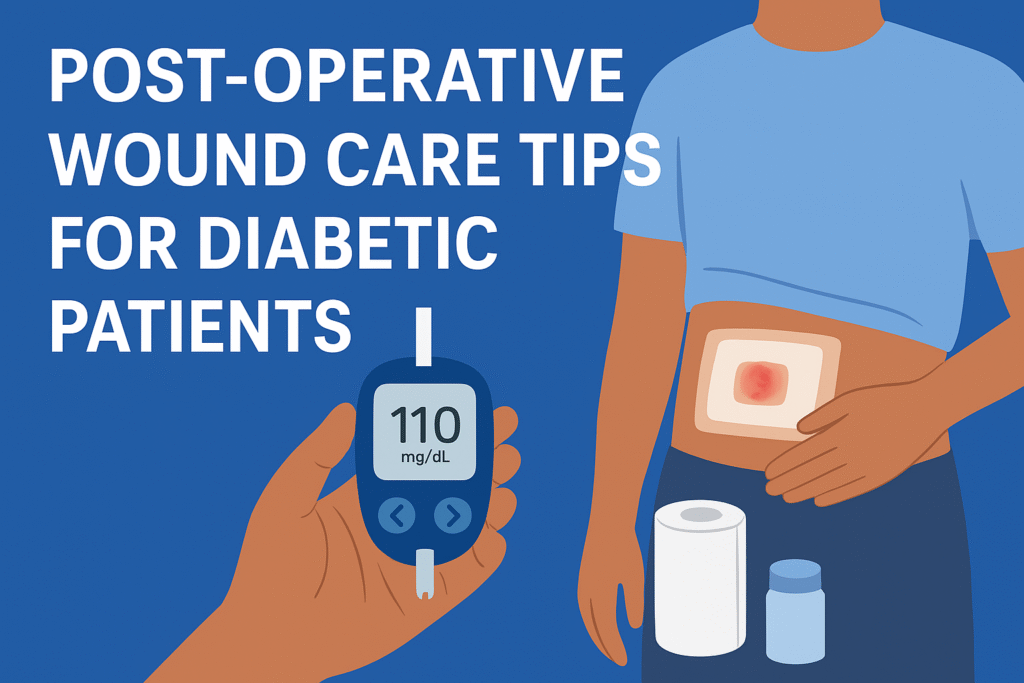
⚠️ Affiliate Disclaimer: This post may contain affiliate links, which means I may earn a small commission — at no extra cost to you — if you make a purchase through one of these links. I only recommend products or services I genuinely trust and believe can provide value. Thank you for supporting My Medical Muse!
Post-Operative Wound Care for Diabetic Patients: 12 Essential Tips for Faster Healing & Recovery
Post-Operative Wound Care Tips for Diabetic Patients: A Complete Guide to Healing and Recovery
Recovering from surgery can be challenging for anyone, but for diabetic patients, it comes with unique considerations that require careful planning and attention. High blood sugar levels can slow down the body’s natural healing process, increase the risk of post-operative infections, and extend the overall recovery period. Even minor complications can lead to serious consequences if not addressed promptly, making meticulous wound care essential.
Diabetes affects multiple aspects of the healing process, circulation is often reduced, the immune system may be less effective, and nerve damage can prevent patients from noticing early signs of complications. This combination of factors makes diabetic patients more vulnerable to wound-related issues compared to non-diabetic individuals.
In this comprehensive guide, we will provide a step-by-step roadmap for safe and effective post-operative care tailored specifically for diabetic patients. You will learn:
- Why wounds heal more slowly in diabetes and the biological mechanisms behind it.
- Pre-surgery preparation tips to optimize your body for healing.
- Step-by-step post-operative wound care routines to prevent infection and promote faster recovery.
- Nutrition and lifestyle strategies to support tissue repair and immune function.
- Early warning signs of complications and guidance on when to seek immediate medical attention.
- Long-term strategies for scar care, mobility, and overall recovery, ensuring that healing is complete and sustainable.
Whether you are undergoing minor outpatient surgery or major procedures, understanding and following proper wound care protocols can make the difference between a smooth recovery and prolonged complications. This guide is designed to empower diabetic patients and caregivers with practical, actionable steps to achieve optimal healing outcomes while minimizing risks.
Why Wound Care is Different for Diabetic Patients
Post-operative wounds are essentially controlled injuries that rely on the body’s natural healing process to close, repair, and restore tissue. In a healthy individual, this process involves a carefully orchestrated cascade of events: inflammation, tissue formation (proliferation), and remodeling (maturation). Each stage is crucial for proper healing and scar formation.
In diabetic patients, however, multiple physiological factors disrupt these stages, making wound care more complex and demanding:
1. Reduced Blood Circulation
High blood sugar can damage small blood vessels, a condition known as microvascular disease. Poor circulation reduces the delivery of oxygen and essential nutrients to the wound site, which are critical for cellular repair and collagen formation. Without adequate blood flow, tissues remain vulnerable and healing is significantly delayed.
2. Impaired Immune Function
Diabetes can weaken the immune system. White blood cells, which are responsible for fighting bacteria and clearing damaged tissue, become less efficient in high-glucose environments. This increases the risk of infections, even from minor bacterial exposure, and slows the overall healing process.
3. Neuropathy (Nerve Damage)
Many diabetic patients experience peripheral neuropathy, which reduces sensation in affected areas, particularly the hands and feet. This can make it difficult to detect early signs of wound complications, such as pressure, irritation, or infection, allowing problems to progress unnoticed.
4. High Infection Risk
Elevated blood sugar creates a favorable environment for bacteria and fungi, increasing susceptibility to post-operative infections. Even small wounds can quickly become infected if not properly monitored and managed, leading to prolonged recovery, additional medical interventions, or in severe cases, hospitalization.
5. Delayed Cellular Repair
Chronic hyperglycemia can interfere with collagen synthesis and fibroblast activity, both of which are essential for wound closure and strength. This not only slows healing but may also result in weaker scar formation, increasing the risk of wound reopening or breakdown.
Because of these combined challenges, impaired circulation, weakened immunity, neuropathy, and high infection risk, diabetic patients require extra vigilance and proactive wound care. Following strict pre- and post-operative protocols, monitoring wounds closely, and maintaining optimal blood sugar levels are essential for preventing complications and achieving successful healing.
Pre-Surgery Preparations for Better Healing
Proper preparation before surgery can significantly improve wound healing and reduce complications for diabetic patients. Focusing on blood sugar control, nutrition, medication management, and skin care ensures your body is ready to repair itself efficiently.
1. Optimize Blood Sugar Control
Stable blood glucose levels before surgery are critical for reducing infection risk and promoting healing:
- Monitor glucose regularly: Track fasting, pre-meal, and post-meal levels.
- Target ranges:
- Fasting glucose: 80-130 mg/dL
- Post-meal glucose: <180 mg/dL
- Hemoglobin A1C: Ideally <7%, or as advised by your doctor.
- Fasting glucose: 80-130 mg/dL
- Medication management: Work with your healthcare provider to adjust insulin or oral medications if necessary.
- Meal planning: Eat balanced meals with complex carbs, lean protein, and healthy fats to maintain stable glucose levels.
- Hydration: Drink enough water to support circulation and tissue repair.
2. Stop Smoking & Limit Alcohol
- Smoking: Nicotine reduces blood flow to tissues, slowing healing and increasing infection risk. Ideally, quit 4-6 weeks before surgery.
- Alcohol: Can impair immune function and destabilize blood sugar. Limit or abstain in the pre-operative period.
3. Discuss Medication Adjustments
- Diabetes medications: Some drugs may need dose modifications to prevent hypoglycemia during fasting periods.
- Other medications & supplements: Blood thinners, NSAIDs, and certain herbal supplements (e.g., vitamin E, ginkgo) may increase bleeding risk and require temporary discontinuation.
- Always consult your doctor before making any changes.
4. Improve Nutrition
Nutrition plays a key role in tissue repair and immunity:
- Protein: Eggs, lean meat, fish, dairy, legumes support collagen formation.
- Vitamins:
- Vitamin A: Supports tissue growth
- Vitamin C: Enhances collagen synthesis and immunity
- Vitamin E: Antioxidant protection
- Vitamin A: Supports tissue growth
- Minerals: Zinc aids wound repair.
- Balanced diet: Combine complex carbohydrates, healthy fats, and fiber to maintain stable blood sugar.
5. Foot & Skin Care Check
- Inspect feet and lower limbs daily for cuts, blisters, fungal infections, or pressure sores.
- Treat any wounds or infections before surgery.
- Moisturize to prevent cracks or dryness that can serve as entry points for bacteria.
6. Additional Pre-Surgery Tips
- Maintain adequate hydration for circulation.
- Plan post-surgery support, including help with mobility, dressing changes, and medication management.
- Educate yourself on your wound care plan and ask your surgical team any questions before the procedure.
Post-Operative Wound Care: Step-by-Step Guide
1. Keep Blood Sugar Under Control
Maintaining optimal glucose levels after surgery is the most important factor in preventing infection and promoting healing:
- Monitor frequently: 4-6 times daily, including fasting and post-meal readings.
- Medication adherence: Take insulin or other diabetes medications exactly as prescribed; adjust only under medical guidance.
- Maintain a log: Record glucose readings to share with your healthcare provider for timely adjustments.
- Avoid glucose spikes: Eat balanced, nutrient-rich meals and avoid high-sugar foods.
Why it matters: High blood sugar delays the immune response, slows collagen production, and increases the risk of post-operative infections, making meticulous glucose control crucial.
2. Post-Operative Wound Care: Step-by-Step Guide
Proper post-operative wound care is essential for diabetic patients to prevent complications, accelerate healing, and reduce infection risk. Follow your surgeon’s instructions exactly, but these detailed steps provide a practical framework.
Follow Wound Cleaning Protocol
Diabetic patients are particularly prone to infections, so hygiene and proper cleaning are critical.
Step-by-step cleaning procedure:
- Wash hands thoroughly with soap and warm water before touching the wound or supplies.
- Prepare a clean workspace with all necessary supplies (sterile gauze, saline solution, prescribed ointments).
- Remove old dressing carefully to avoid reopening the wound.
- Clean the wound using mild saline solution or any solution prescribed by your healthcare provider. Avoid harsh antiseptics unless specifically advised, they can damage new tissue.
- Pat dry gently with sterile gauze; do not rub or scrub the wound.
- Apply prescribed ointments or medications evenly on the wound surface.
- Cover with a sterile dressing to protect against bacteria and maintain a moist healing environment.
Avoid home remedies such as toothpaste, raw honey, or herbal pastes unless explicitly approved by your doctor, as they can introduce bacteria or delay healing.
3. Change Dressings Regularly
- Follow your surgeon’s recommended frequency (often once or twice daily in the early stages).
- Always use sterile materials.
- Avoid touching the wound directly with bare fingers.
- Keep a dressing log to monitor changes in appearance, discharge, or odor.
4. Maintain Good Circulation
Proper circulation promotes oxygen and nutrient delivery to the wound, which is critical for tissue repair:
- Elevate the wound (for limb surgeries) to reduce swelling.
- Avoid tight clothing or bandages that restrict blood flow.
- Perform gentle, approved movements to stimulate circulation, such as ankle pumps or light walking if recommended.
5. Manage Pain Wisely
Pain control supports mobility and proper wound care:
- Take pain medications as prescribed.
- Avoid overuse of NSAIDs unless approved they can interfere with tissue healing or blood clotting.
- Proper pain management allows you to move safely, improving circulation and reducing complications like blood clots.
Infection Prevention Strategies
Diabetic patients are more susceptible to infections, making early prevention critical.
Practical steps:
- Follow showering guidelines strictly; some wounds must remain dry for several days.
- Avoid swimming or soaking in baths, hot tubs, or pools until your healthcare provider confirms it is safe.
- Keep pets and potentially contaminated objects away from the wound.
- Wear loose, breathable clothing to reduce moisture and friction.
Watch for warning signs of infection:
- Redness spreading beyond the wound edges
- Increased swelling, warmth, or tenderness
- Thick, yellow, or foul-smelling discharge
- Fever or chills
If any of these signs appear, contact your healthcare provider immediately. Early intervention is crucial to prevent serious complications.
Nutrition for Faster Healing
Proper nutrition after surgery is essential for tissue repair, immune function, and maintaining stable blood sugar in diabetic patients. A well-balanced diet accelerates healing, reduces infection risk, and supports overall recovery.
Key Nutrients for Recovery
- Protein-Rich Foods
Protein is vital for collagen formation and tissue repair. Include:- Eggs
- Lean meats (chicken, turkey, beef)
- Fish and seafood
- Dairy products (milk, yogurt, cheese)
- Legumes (beans, lentils, chickpeas)
- Eggs
- Vitamin C: Supports collagen synthesis, strengthens immunity, and promotes wound healing:
- Citrus fruits (oranges, lemons, grapefruits)
- Berries (strawberries, blueberries, raspberries)
- Bell peppers, broccoli, and tomatoes
- Citrus fruits (oranges, lemons, grapefruits)
- Zinc:
Crucial for immune function and cellular repair:- Nuts and seeds (almonds, pumpkin seeds)
- Whole grains (oats, brown rice, quinoa)
- Legumes
- Nuts and seeds (almonds, pumpkin seeds)
- Healthy Fats:
Reduce inflammation and support nutrient absorption:- Avocado
- Olive oil
- Fatty fish (salmon, mackerel, sardines)
- Nuts
- Avocado
- Adequate Hydration: Proper fluid intake improves circulation and tissue repair:
- Aim for 8-10 glasses of water daily, adjusting for activity and climate.
- Avoid sugary drinks that spike blood sugar.
- Aim for 8-10 glasses of water daily, adjusting for activity and climate.
Foods to Avoid
- Excessive sugary foods and desserts
- Highly processed snacks
- Alcohol, which impairs immune function and can destabilize glucose levels
Special Considerations for Common Surgical Sites
Different surgical procedures require tailored post-operative care. Diabetic patients must pay extra attention to these guidelines to minimize complications:
Abdominal Surgery
- Support incision: Hold a pillow over the wound when coughing or standing up.
- Avoid heavy lifting: Refrain from lifting objects over 10-15 lbs for at least 6 weeks, or as advised.
- Monitor for complications: Watch for hernias, swelling, redness, or discharge.
Foot & Leg Surgery
- Diabetic-friendly footwear: Use supportive, well-fitted shoes to reduce pressure and prevent ulcers.
- Daily inspection: Check feet for blisters, redness, or pressure sores.
- Avoid walking barefoot: Protects against infections and unnoticed injuries.
- Pressure offloading: Use cushions, bandages, or crutches as recommended.
Cardiac Surgery
- Keep incision clean and dry: Follow your surgeon’s instructions for bathing and dressing changes.
- Limit arm movement: Avoid raising both arms overhead simultaneously in the first weeks to prevent strain.
- Gradual activity: Begin light walking or physiotherapy as recommended, increasing intensity gradually.
The Role of Physical Activity in Healing
Physical activity plays a critical role in post-operative recovery for diabetic patients. Gentle, controlled movement improves blood circulation, delivering oxygen and nutrients to the wound site, which accelerates healing. It also helps prevent complications such as blood clots, muscle stiffness, and pressure ulcers.
Practical recommendations:
- Start with gentle walking: As soon as your healthcare provider approves, begin light walking to stimulate circulation and maintain mobility.
- Avoid high-impact or strenuous activities: Running, jumping, heavy lifting, or contact sports should be postponed until your surgeon confirms the wound is fully healed.
- Use physiotherapy if recommended: Physical therapists can design safe, progressive exercises tailored to your surgery type and diabetic condition.
- Incorporate daily mobility: Simple ankle pumps, stretching, and short walks help prevent stiffness and improve recovery outcomes.
When to Seek Immediate Medical Attention
Diabetic patients are at increased risk of post-operative complications. Prompt recognition and treatment are vital. Contact your healthcare provider or go to the emergency room if you notice:
- Persistent or worsening pain despite prescribed medication
- Rapid swelling, redness, or warmth spreading from the wound
- Fever above 100.4°F (38°C)
- Bleeding that does not stop with gentle pressure
- Signs of uncontrolled blood sugar:
- Hyperglycemia >250 mg/dL that cannot be corrected
- Hypoglycemia <70 mg/dL not responsive to glucose intake
- Hyperglycemia >250 mg/dL that cannot be corrected
Early intervention can prevent minor issues from becoming serious infections or systemic complications.
Long-Term Healing and Scar Care
Once the wound has closed and initial healing is complete, ongoing care helps minimize scar formation and maintain skin health:
- Moisturize: Use doctor-approved lotions or ointments to keep the scar tissue hydrated.
- Sun protection: Protect the scar from direct sunlight; UV exposure can darken and thicken scars permanently.
- Consider silicone gel sheets: These can flatten scars, reduce redness, and improve cosmetic outcomes.
- Monitor for late complications: Be alert for delayed infections, dehiscence (wound reopening), or unusual skin changes.
Emotional & Mental Wellbeing
Recovery from surgery can be physically and emotionally challenging, especially for patients managing diabetes. Stress and anxiety can also affect blood sugar control and healing.
Support strategies:
- Connect with support groups: Sharing experiences with other diabetic patients can provide encouragement and practical tips.
- Relaxation techniques: Deep breathing exercises, meditation, or guided imagery can reduce stress and promote healing.
- Professional help: If you experience persistent anxiety, depression, or feelings of hopelessness, consult a mental health professional for guidance.
Key Takeaways
- Blood sugar control is foundational for optimal wound healing in diabetic patients.
- Strictly follow your surgeon’s wound care instructions to prevent complications.
- Eat a nutrient-rich diet rich in protein, vitamins, and minerals to support tissue repair.
- Monitor wounds closely for infection or abnormal changes.
- Seek medical attention promptly if warning signs appear, early treatment prevents serious complications.
Final Word
Recovering from surgery as a diabetic patient may feel daunting, but it is entirely possible to achieve excellent healing outcomes comparable to those of non-diabetic individuals. The difference lies not in limitations, but in proactive management, careful monitoring, and consistent self-care.
Every step you take from keeping your blood sugar within target ranges to following your surgeon’s wound care instructions plays a critical role in your recovery. Think of your healing journey as a team effort: your healthcare providers provide guidance and expertise, while your daily choices, nutrition, hygiene, activity, and vigilance directly influence the results.
The key is consistency and attentiveness. Checking your wound regularly, recognizing early warning signs, maintaining a nutrient-rich diet, staying active within approved limits, and managing stress are not just tasks, they are tools that empower you to take control of your recovery.
Remember, complications are not inevitable, with careful planning, adherence to medical guidance, and a mindset focused on steady progress, you can heal safely, regain strength, and return to your normal life with confidence. Your recovery is not just about the surgery, it’s about your active role in supporting your body every step of the way.
Embrace the process, stay vigilant, and trust in the healing power of your body supported by smart, consistent care.
👩⚕️ Need Personalized Health Advice?
Get expert guidance tailored to your unique health concerns through MuseCare Consult. Our licensed doctors are here to help you understand your symptoms, medications, and lab results—confidentially and affordably.
👉 Book a MuseCare Consult NowRelated Blog Post You Might Like:
- Can Intermittent Fasting Help Type 2 Diabetes? 9 Powerful Facts
- 10 Sneaky Symptoms of Prediabetes in Women Over 40 You Can’t Ignore
- 7 Proven Ways to Prevent Pressure Ulcers in Wheelchair-Bound Patients
- 10 Proven Tips on How to Interpret Hemoglobin A1c Levels Accurately
- Reverse Neuropathy with Diet: 10 Science-Backed Foods That Heal Nerves


